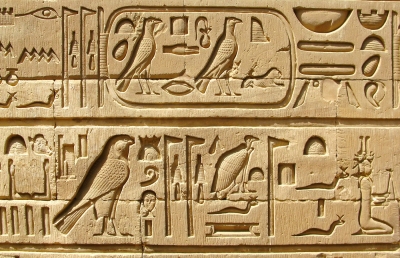
The ancient Egyptians used the distinctive script known today as hieroglyphs (Greek for “sacred words”) for almost 4,000 years. Hieroglyphs were written on papyrus, carved in stone on tomb and temple walls, and used to decorate many objects of cultic and daily life use. Altogether there are over 700 different hieroglyphs, some of which represent sounds or syllables; others that serve as determinatives to clarify the meaning of a word. The hieroglyphic script originated shortly before 3100 B.C., at the very onset of pharaonic civilization. The last hieroglyphic inscription in Egypt was written in the 5th century A.D., some 3500 years later. For almost 1500 years after that, the language was unable to be read. In 1799, the Rosetta Stone was discovered in Egypt by Napoleon’s troops. The Rosetta Stone is a trilingual decree (written in hieroglyphs, Greek, and Demotic) dating to the time of Ptolemy V (205-180 B.C.). Its discovery proved to be a crucial link in unlocking the mysteries of Egyptian hieroglyphs and in 1822, enabling Jean-François Champollion to re-decipher the hieroglyphic signs, thereby allowing the modern study of Egyptian language to begin.
The most ancient hieroglyphs date from the end of the 4th millennium BCE and comprise annotations incised onto pottery jars and ivory plaques deposited in tombs, presumably for the purpose of identification of the dead. Although by no means can all of these earliest signs be read today, it is nonetheless probable that these forms are based on the same system as the later classical hieroglyphs. In individual cases, it can be said with certainty that it is not the copied object that is designated but rather another word phonetically similar to it. This circumstance means that hieroglyphs were from the very beginning phonetic symbols. An earlier stage consisting exclusively of picture writing using actual illustrations of the intended words cannot be shown to have existed in Egypt; indeed, such a stage can with great probability be ruled out. No development from pictures to letters took place; hieroglyphic writing was never solely a system of picture writing. It can also be said with certainty that the jar marks (signs on the bottom of clay vessels) that occur at roughly the same period do not represent a primitive form of the script. Rather, these designs developed in parallel fashion to hieroglyphic writing and were influenced by it.
It is not possible to prove the connection of hieroglyphs to the cuneiform characters used by the Sumerians in southern Mesopotamia. Such a relationship is improbable because the two scripts are based on entirely different systems. What is conceivable is a general tendency toward words being fixed by the use of signs, without transmission of particular systems.
Credit : Britannica
Picture Credit : Google




